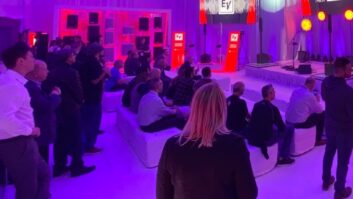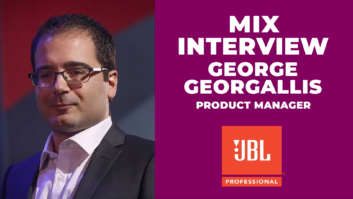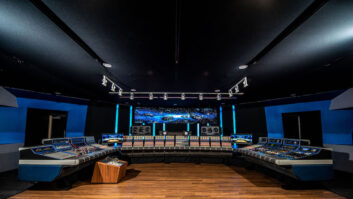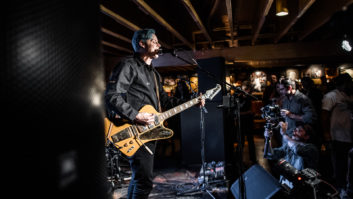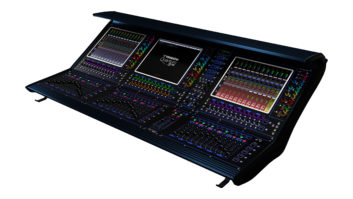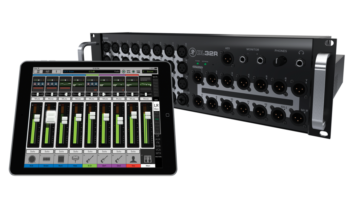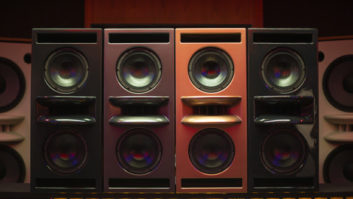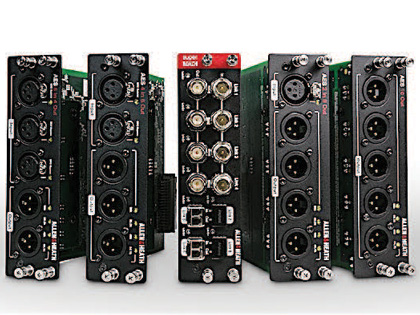
The following new product entries mark some the most interesting large-format live mixing products announced thus far in 2017. All of the following incorporate touch GUIs, are notably versatile, modular and/or expandable, and are ready for our industry’s increasingly networked live/installed sound environments.
Allen & Heath has expanded the line of digital interface options for its dLive mixing system with superMADI and a range of AES3 I/O cards. The superMADI interface card includes 8 BNC connectors and 4 SFP slots for fiber optic transceivers. Both coaxial and optical formats offer up to 128 I/O at 96 kHz each, and redundancy and sample rate are switchable per link pair, with a choice of Smux or High Speed 96kHz mode. The superMADI card can also be used by engineers and rental companies to link to any MADI-enabled third party console for high-channel-count digital splits, for example, between FOH and monitor positions.
Avid’s flagship live mixer, the Venue S6L, features a bevy of updates in version 5.4, to follow up 5.3’s ability to record and play back up to 128 tracks to and from Pro Tools over Ethernet AVB, and a user-definable fader layouts feature. With Version 5.4, updates have been made to Venue Snapshots and Events systems; a new Output Sharing feature allows any engineer on the AVB network to take ownership of the system’s shared Stage 64 outputs on a per-output card basis and more. Notably, output channels can now be rearranged via dragging and dropping Aux master, Group master and Matrix masters channel strips in the External GUI > Outputs page.
Crest Audio, a division of Peavey Commercial Audio, has announced the pending shipment of its Tactus Digital Mixing Systems (Q3 or Q4). Crest partnered with Waves Audio to create Tactus, a modular touchscreen mixer, processor and controller incorporating Waves’ eMotion LV1 software. The GUI displays all audio routing, processing and mixing tools at hand, working with the Waves Audio’s eMotion Mixer for SoundGrid, The Tactus range comprises three hardware products—Tactus.FOH (the Waves SoundGrid-based audio signal processing engine), Tactus.Stage (32-in/16-out remote stage box that can be linked to make 64/32) and Tactus.Control (a 16-channel surface fea.turing dual motorized master faders with mute, cue and select buttons).

As the company marks its 15th anniversary, DiGiCo has unveiled its new SD12 live mixer, a compact desk based around dual 15-inch touchscreens and 72 input channels with full processing, 36 aux/group buses, a 12 x 8 matrix, LR/LCR bus, 12 stereo FX units, 16 Graphic EQs, 119 Dynamic EQs, 119 multiband compressors and 119 DiGi-TuBes, 12 Control Groups (VCA) and SD Series Stealth Core 2 software. Options include a Dante module, which can be plugged straight into the back of the console, alleviating the need to purchase an Orange Box. A Waves module can also be fitted to take full advantage of the SoundGrid platform.

Aimed at the professional production and install markets, Mackie’s AXIS Digital Mixing System brings to.gether the superb 32-channel DL32R digital mixer with the DC16 control surface to create a system intended for houses of worship, performing arts centers and other small- to mid-sized venues with advanced production needs.

With 32 remote-controllable Onyx+ mic preamps and 16 outputs paired with built-in DSP, the system relies on Dante for communication between the DL32R mixer and DC16 control surface, enabling additional networking capability. Visual feedback is provided by large, full-color channel displays.
PreSonus has introduced the StudioLive 24 digital console/recorder to its StudioLive Series III line, with 24 physical input channels with touch-sensitive, motorized faders and recallable XMAX Class A preamps. The main L/R bus also has a touch-sensitive, motorized fader. All 32 internal channels can be addressed digitally via USB and AVB. PreSonus Capture multitrack recording software with virtual soundcheck runs onboard the StudioLive 24 console, allowing users to record up to 34 tracks to the console’s onboard SD recorder. Recordings are simply transferred to the company’s Studio One software as a session, including fader levels and Fat Channel settings. The Fat Channel processing section presents a plug-in-style workflow that features vintage-style EQ and compression options on every channel, from classic tube limiters to passive EQs. A 6-band, fully parametric EQ is available on all mix outputs.


QSC has effectively updated its entire TouchMix Series with the newly unveiled Version 3.0 software for TouchMix-8 and TouchMix-16 and Version 1.2 for TouchMix-30 Pro. The former provides 20 key enhancements, including Anti-Feedback and Room-Tuning Wizards, Real-Time Analyzer (RTA), Copy-and-Paste, playback of MP3 files on a USB drive, Input Delay, Output PEQ, 15 dB Digital Gain, Channel Overview, Channel Safe, Tap Tempo, Tablet Follows Mixer, additional User Buttons (on connected tablet), and the ability to configure Aux 7/8 and Aux 9/10 as balanced, mono outputs (TouchMix-16). QSC loudspeaker tunings are also present in Version 3.0, including presets for the company’s K.2 Series. The new firmware is available as a free download for current users and will be factory-installed in new production units.

Roland’s flagship M-5000 line offers a compact model, the M-5000C, with 8 outputs and all the power of the full-size M-5000. With its Open High Resolution Configurable Archi.tecture (OHRCA) design, the M-5000C is flexible, ready for Roland’s own proprietary REAC connections, as well as Dante, MADI, Waves SoundGrid, etc. Key features include 24-bit/96kHz op.eration throughout; a built-in 16×16 USB audio interface for laptop recording and playback; and a total of 128 freely assignable audio paths.

The Solid State Logic Live L200 mid-scale console is centered on the company’s unique inverted T chassis console design, keeping key parameters within close reach of the operator. Further, arms can be mounted on either or both sides of the console and can be specified as screen mounts or laptop/utility trays. L200 features a row of three 12-channel Fader Tiles, providing a total of 38 faders including the Master and Focus Faders in the Master Tile. A centrally located 17-inch multi-gesture touchscreen gives users access to all of the console’s functions, plus Quick Controls in the central Fader tile. The Master Tile, located alongside the screen also provides Mute Group, Solo/Talkback, Assignable keys, and Automation controls.

Built specifically for Si Series live mixers, Soundcraft’s new Mini Stagebox 32i and Mini Stagebox 16i provide multiple channels of remote-controlled MADI I/O and Studer-designed preamps in two distinct sizes, either connected to the mixer via standard RJ45/Cat5 cable up to 100 meter runs. The 3U 32i offers 32 mic preamps and A/D converters and 12 XLR analog line level outputs; the 2U 16i offers 16 mic preamps and A/D converters and 8 XLR analog line level outputs. Soundcraft offers a free firmware update for its Si Impact mixing console, enabling up to 80 mix tracks when used in conjunction with stage boxes.
Approximately two-thirds the size of the existing CS-R10 surface, the new Yamaha CS-R10-S control surface offers the same operability for applications in a smaller footprint. A Dual Console function (to be supported in a future update) will allow two CS-R10 and/or CS-R10-S control surfaces to be connected to a single DSP-R10 DSP engine (e.g., FOH and monitor mix positions). A CS-R10-S will also be able to be used as a sidecar for a CS-R10. Also, Yamaha’s TF Series now boasts the no-footprint TF-RACK, a compact, rackmount version of its TF Series of digital mixing consoles, offering every feature of its TF Series desktop models, accessible via third-party GUI. Yamaha specifically notes that it is intended for smaller-scale or portable mixing applications—“particularly when a proper mix position may not be available.”
